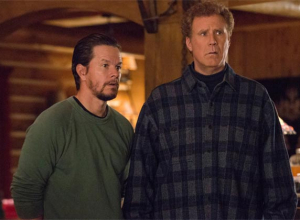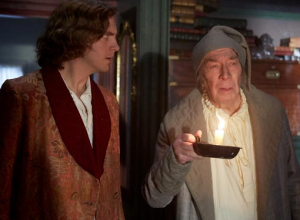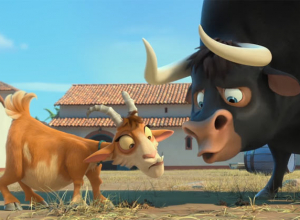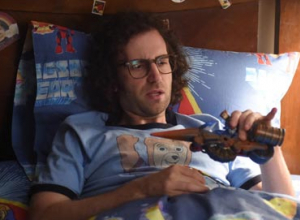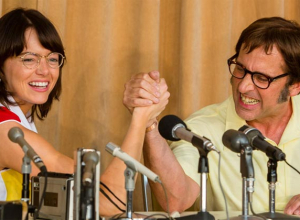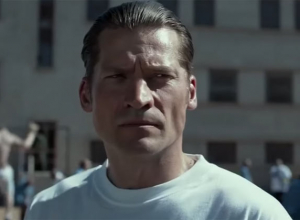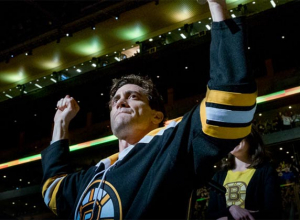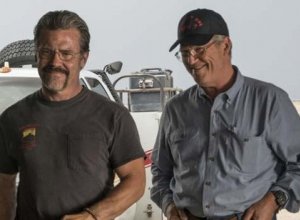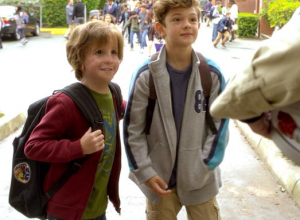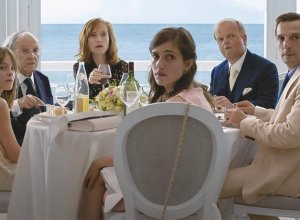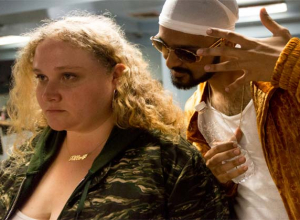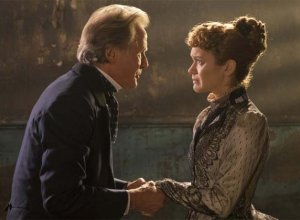Lord Of The Rings: Fellowship Of The Ring Review
By Rob Blackwelder
In the entire three hours of the audacious, transporting, spectacularly cinematic first "Lord of the Rings" installment, there are only two very brief moments that don't come across as being 100-percent a part of the mystical, dark and magical realm of Middle Earth.
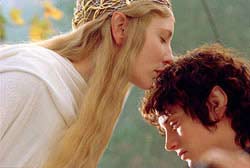
These moments are not because of bad performances (there aren't any), negligent directing or special effects gaffes. In fact, from the digitally dialed-down stature of the actors playing hobbits to the frightfully demonic hoards of living-dead orcs (minions of the supernaturally evil antagonist), the effects are seamless.
These moments of doubt are merely scenes that take place in such plain locations (e.g. a non-descript river bed) that they seem far too familiar and Earthly in a movie of underground troll cities, ominous mountains called Doom, idyllic ancient forest hamlets of immortal elves, and hobbit's homes burrowed into impossibly green hillsides.
Zealously dedicated director Peter Jackson ("Heavenly Creatures," "The Frighteners") has brought the monumental ambience, the distinctive characters and the indelible spirit of "Lord of the Rings: Fellowship of the Ring" to life so tangibly that it took my breath away.
For the uninitiated, this film is the first of a trilogy adapted from J.R.R. Tolkien's weighty, layered, complexly detailed epic fantasy trilogy, replete with mythical species of beast and humanoid (hobbits, elves, dwarfs, wizards), and rife with classic themes of good versus evil.
Its unmistakable influence can be felt in everything from science fiction ("Star Wars") to video games ("Myst") to Led Zeppelin songs ("Misty Mountain Hop," "The Battle of Evermore") to Goth culture. Yet at its core is an ostensibly simple, metaphysical story of one omnipotent gold ring, which was forged by Sauron the dark Lord of Mordor, inscribed with a spell and sought by all who desire power, and which has been missing for 3,000 years.
"Fellowship" opens with a brisk, booming historical backstory about a whole slew of enchanted rings given to the leaders of the aforementioned race. This prologue is accompanied by a CGI-ed battle scene of incredible proportions between the armies of these (mostly) virtuous cultures and hoards of sinewy, ghoulish undead minions that serve Sauron, who created his one ring to control all others. Sauron was defeated and his ring was lost, but not until after its influence has wrought eons of chaos upon its inheritors.
Many centuries later the ring is stumbled upon by an unsuspecting hobbit (a diminutive, hairy-footed, happy-go-lucky breed of people) named Bilbo Baggins (Ian Holm), who squirrels it away like a secret treasure. Then on his 111th birthday, Bilbo leaves the comfort of his earthen home in a bucolic shire to spend his retirement in Rivendell, the waterfall-scenic city of the elves.
The ring passes into the hands of Bilbo's young cousin Frodo (Elijah Wood), who is visited by Gandalf the Wizard (Ian McKellen) with a warning: Now that the ring has been located, Sauron and his armies will be rising from the ashes to claim it at all costs. To stop him, the ring must be destroyed in the fires that created it on Mt. Doom, Sauron's lair. The whole "Lord of the Rings" trilogy (the sequels were filmed simultaneously for release in 2002 and 2003) is the story of the quest to do so.
Wide-eyed young Frodo, a teenager in hobbit years, is more than apprehensive about being charged with this crusade, and Wood's performance captures the weight of his character's bewilderment with credible, captivating ingenuousness. But wise, warm, distressed Gandalf insists vehemently, knowing Frodo is the only person with a heart pure enough to bear the ring to its destiny without succumbing to its virulent influence.
Frodo embarks on this adventure escorted by three hobbit friends and a shaky, distrustful alliance of heroic warriors. One is a Viking-like dwarf (John Rhys-Davies), another a bow-wielding, ethereal elf (Orlando Bloom), and two are humans, played by Viggo Mortensen ("A Perfect Murder") and Sean Bean ("GoldenEye"), breaking out of their bad-guy typecasting to provide their heroes with heart and palpable internal strife. Meanwhile, elderly Gandalf engages in a wizard-fu mano-a-mano with a powerful former ally and sorcerer named Saruman (Christopher Lee, chewing just the right amount of scenery), who has become a servant of Sauron and is amassing his hellspawn army.
While making friends (Cate Blanchett, Liv Tyler and Hugo Weaving give strong performances as immortal elves) and facing enemies along the way, Frodo and his fellowship run up against the movie's two undermining problems along the path to Mt. Doom.
The first is that the picture's middle hour is a repetitive series of trials for our heroes -- journey-and-skirmish episodes so similar (battle against a mystical creature or demonic antagonist without major injury to heroes; trek to a new location; repeat) that on a couple occasions I rolled my eyes and thought, "Here we go again..."
The second is that the film ends mid-journey with a non-finale that is true to the book, but so abrupt and unsatisfying it almost feels as if the director is laughing from behind the screen, knowing he's left you hanging until the next installment -- 12 months away. The practical upshot of this is that "Fellowship" will never be able to stand on its own as a motion picture.
I have other complaints (Howard Shore's score is overwrought and far too dependent on annoyingly jaunty recorder music), but for an adaptation of this magnitude, the very devoted Jackson gets almost everything right. So much so that this prodigious production should duly impress any neophyte and deeply satisfy Tolkien's cultish legions of fans.
From the hobbits' modest shire to the dwarfs' elaborate caverns to the waterfalls of Rivendell, the production design is absolutely other-worldly on a scale that has to be seen to be believed. The photography is both beautiful and crafty (there's an aerial tracking shot through a forest that's just astounding). The many sword fights are varied and exciting. The costumes and makeup, especially on the beastly ringwraiths with their demonic faces and exoskeleton armor, are an awesome success.
For once, here's a gigantic-budget movie that wears its outsized grandiosity well and lives up to its hype and ambition. More importantly, the characters are perfectly cast (can you think of any actresses more elfin than Blanchett and Tyler?) and properly, reverentially steeped in Tolkien's elaborate mythology.
At times it may be hard to keep up with the picture's multitude of narrative particulars (which warriors are descended from kings, the origins of the ringwraiths). But while any shortcomings of "Fellowship of the Ring" -- be they trivial, trite or troubling -- will inevitably be the topics of debate among fans and film buffs alike, this film may well be the all-time cinematic champion of the fantasy genre.
Facts and Figures
Year: 2001
In Theaters: Monday 7th April 2008
Box Office Worldwide: $871.4M
Budget: $93M
Production compaines: New Line Cinema, WingNut Films, The Saul Zaentz Company
Reviews
Contactmusic.com: 3 / 5
IMDB: 4.1 / 10
Cast & Crew
Director: Peter Jackson
Starring: Elijah Wood as Frodo Baggins, Ian McKellen as Gandalf the Grey, Viggo Mortensen as Aragorn, Liv Tyler as Arwen Evenstar, Orlando Bloom as Legolas, John Rhys-Davies as Gimli, Sean Bean as Boromir, Christopher Lee as Saruman, Sean Astin as Samwise 'Sam' Gamgee, Billy Boyd as Peregrin 'Pippin' Took, Dominic Monaghan as Meriadoc 'Merry' Brandybuck, Hugo Weaving as Elrond, Cate Blanchett as Galadriel, Ian Holm as Bilbo Baggins, Craig Parker as Haldir, Lawrence Makoare as Lurtz, Sala Baker as Sauron, Andy Serkis as Gollum, Sarah McLeod as Rose 'Rosie' Cotton, Marton Csokas as Celeborn
Also starring: Karl Urban

